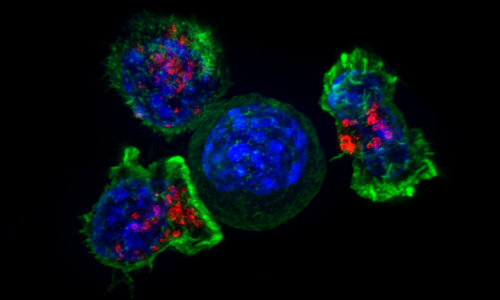Loading
Journal of Cancer Immunology
ISSN: 2689-968X
All Articles
Prevalence of Symptom Clusters in Cancer Patients at First Presentation in Palliative Care Clinic as per Different Disease Groups
Irum Ghafoor, Haroon Hafeez, Farhat Naz, Muhammad Abubakar, Arif Jamshed
Cancer has its own disease burden and patients usually suffer from symptom clusters when they are referred for palliative treatment. Identification of symptom cluster trajectories will help clinician to take into account measures that can optimize quality of life of palliative patients. Therefore the aim of this paper is to determine the overall prevalence of symptoms and symptoms clusters in different disease groups according to etiology at the time of first visit to Palliative care clinic by using HIS Palliative First Assessment note indicating Edmonton symptom scale.
J Cancer Immunol, 2019, Volume Volume 1, Issue Issue 1 | DOI: 10.33696/cancerimmunol.1.001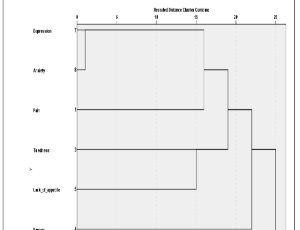
Chimeric Antigen Receptor CAR NK Cells Emerging Immunotherapy for the Treatment of Cancer
Sachin Kumar Deshmukh
Although NK cells are recognized as effector lymphocytes of the innate immune system, they also regulate the adaptive immune response by releasing inflammatory cytokines and developing immunological memory. Unlike other lymphocytes such as T or B cells, NK cells do not express rearrangeable, antigen-specific receptors.
J Cancer Immunol, 2019, Volume Volume 1, Issue Issue 1 | DOI: 10.33696/cancerimmunol.1.002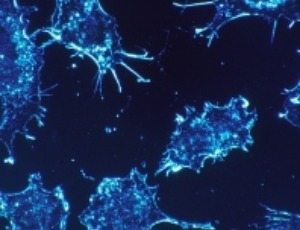
pMB FLASH - Status and Perspectives of Combining Proton Minibeam with FLASH Radiotherapy
Judith Reindl, Stefanie Girst
Proton minibeam radiotherapy (pMBRT) is an external beam radiotherapy method with reduced side effects by taking advantage of spatial fractionation in the normal tissue. Due to scattering, the delivered small beams widen in the tissue ensuring a homogeneous dose distribution in the tumor. In this review, the physical and biological principles regarding dose distribution and healing effects are explained. In the last decade, several preclinical studies have been conducted addressing normal tissue sparing and tumor control in-vitro and in-vivo, using human skin tissue and mouse or rat models. The major results acquired in these studies are summarized. A further newly emerging therapy method is FLASH radiotherapy, i.e. the treatment using ultra-high dose rates. The possibility of combining these methods in proton minibeam FLASH therapy (pMB FLASH) is worked out. Additionally, technical feasibility and limitations will be discussed by looking at simulations as well as preclinical studies and also pointing out new ways of delivering the desired tumor dose, such as interlacing. We will also highlight the opportunities that emerge regarding high dose radiation, hypofractionation and the combination with immunotherapy.
J Cancer Immunol, 2019, Volume Volume 1, Issue Issue 1 | DOI: 10.33696/cancerimmunol.1.003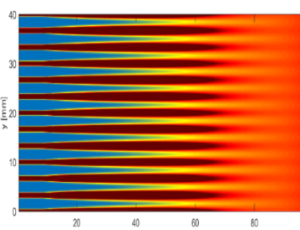
Role of Liver Navigation in Surgery Planning and the Challenges
Sarada Prasad Dakua, Sagnika Dash, Sagarika Pati, Julien Abinahed
With continuous advancement of high dimensional imaging devices and the development of new image computing and visualization techniques, the world of interventional radiology and surgical care has achieved new heights. Computer vision and image processing plays an important role in health care, such as analysis, visualization, and exploration of medical image data.
J Cancer Immunol, 2023, Volume Volume 5, Issue Issue 1, p1-4 | DOI: 10.33696/cancerimmunol.5.070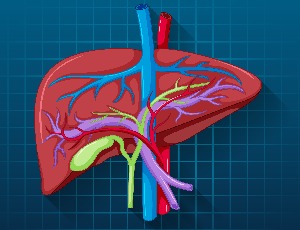
TFAP-2: A Special Regulator with Bidirectional Effect in Human Cancer
Li-Nan Wang, Yi-Liu Yang, Lin-Yong Zhao
Abnormality of transcription factors’ activity has been found in signal pathways of many cancers. The AP-2 family of transcription factors?TFAP2?is one of the most representative families with this characteristic. The family, consisting of five members (TFAP2A to TFAP2E), can activate or inhibit the target gene through signal transduction. They have been found to play important roles in human embryonic development and cell differentiation.
J Cancer Immunol, 2021, Volume Volume 3, Issue Issue 1, p1-5 | DOI: 10.33696/cancerimmunol.3.035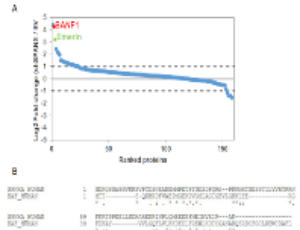
Leucocyte-Tumor Cell Hybridization Can Initiate Cancer Metastasis
John M. Pawelek, Zachary Grasmick, Eric Duvall, Greggory S. LaBerge
According to estimates from the International Agency for Research on Cancer, by the year 2030 there will be 22 million new cancer cases and 13 million deaths per year. The main reason for death from cancer is not the initial tumor but it’s metastasis to distant parts of the body, yet this process has remained poorly understood for quite some time.
J Cancer Immunol, 2020, Volume Volume 2, Issue Issue 1, p1-9 | DOI: 10.33696/cancerimmunol.2.006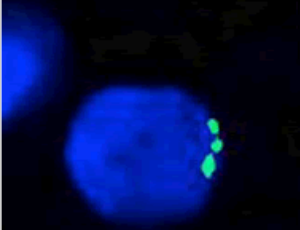
Clinical, FDG-PET and Molecular Markers of Immune Checkpoint Inhibitor Response in Patients with Advanced Merkel Cell Carcinoma
Julia R Dixon-Douglas, Luke S McLean, Alex Caneborg, Richard W Tothill, Grace Kong, Rodney J Hicks, Shahneen Sandhu
Merkel cell carcinoma (MCC) is a rare, highly aggressive, neuroendocrine cancer of the skin with an increasing incidence. MCC occurs predominantly in older adults with risk factors including high exposure to ultra-violet (UV) light and immunosuppression.
J Cancer Immunol, 2022, Volume Volume 4, Issue Issue 1, p1-11 | DOI: 10.33696/cancerimmunol.4.058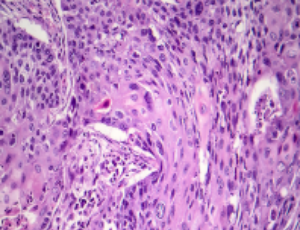
The Role of Tumor and Host Microbiome on Immunotherapy Response in Urologic Cancers
John Pfail, Jake Drobner, Krishna Doppalapudi, Biren Saraiya, Vignesh T. Packiam, Saum Ghodoussipour
The role of the microbiome in the development and treatment of genitourinary malignancies is just starting to be appreciated. Accumulating evidence suggests that the microbiome can modulate immunotherapy through signaling in the highly dynamic tumor microenvironment. Nevertheless, much is still unknown about the immuno-oncology-microbiome axis, especially in urologic oncology. The objective of this review is to synthesize our current understanding of the microbiome’s role in modulating and predicting immunotherapy response to genitourinary malignancies.
J Cancer Immunol, 2024, Volume Volume 6, Issue Issue 1, p1-13 | DOI: 10.33696/cancerimmunol.6.078
Exogenous Heat Shock Proteins HSPA1A and HSPB1 Interact with TLR2, TLR4, TLR5, and TLR7 on Differentiated U937 Monocytic Cells
Emmanuel Ogbodo, Francesco Michelangeli, John H.H. Williams
Biological cells are sensitive to both pathological and non-pathological stress, which can activate the innate immune response. This activation often involves the release of heat shock proteins (HSPs), such as HSPA1A and HSPB1. However, the implications and relationships between HSP release and immune system activation remain unclear. While evidence suggests that HSPs play a role in immune system activation and regulation, their immune regulatory characteristics are still debated.
J Cancer Immunol, 2025, Volume Volume 7, Issue Issue 1, p1-14 | DOI: 10.33696/cancerimmunol.7.099
Early Integration of Palliative Care for Patients Receiving Systemic Immunotherapy for Renal Cell Carcinoma
Megan Stout, Akshay Thaper, Vivien Xu, Eric A. Singer, Biren Saraiya
Palliative care (PC) aims to prioritize the quality of life and comfort of those with complex and terminal illnesses through the physical, psychological, social, and spiritual needs of the individual. Palliative care can support individuals from the day of their cancer diagnosis through end-of-life and bereavement
J Cancer Immunol, 2023, Volume Volume 5, Issue Issue 1, p5-12 | DOI: 10.33696/cancerimmunol.5.072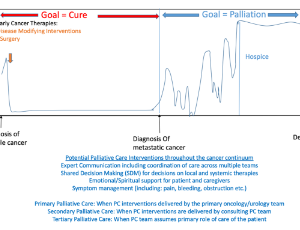
Long Non-coding RNAs in the Pathophysiology of Multiple Myeloma New Insights on the Role of CRNDE
Simone Zocchi, Antoine David, Michele Goodhardt, David Garrick
Over the past 15 years, long non-coding RNAs (lncRNA) have emerged as an important class of regulatory molecules. The currently accepted definition is that lncRNA refers to RNA molecules with little or no protein-coding potential, and which are greater than 200 nucleotides in length, a size cut-off chosen largely to distinguish them from the more-extensively characterised group of small non-coding regulatory RNAs, which includes micro (mi)RNAs, small inhibitory (si)RNAs and PIWI-interacting (pi)RNAs.
J Cancer Immunol, 2021, Volume Volume 3, Issue Issue 1, p6-12 | DOI: 10.33696/cancerimmunol.3.036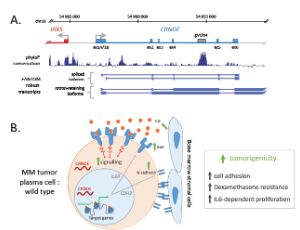
CTLA-4 and PD-L1 or PD-1 Pathways: Immune Checkpoint Inhibitors and Cancer Immunotherapy
Sachin Kumar Deshmukh
The immune system developed certain checks and balance to control or inhibit the reactivity against normal cells of the body. Uncontrolled immune responses to the non-self entities such as bacteria, viruses, parasites, or mutated self-antigens can cause an inflammatory reaction and autoimmune diseases.
J Cancer Immunol, 2020, Volume Volume 2, Issue Issue 1, p10-12 | DOI: 10.33696/cancerimmunol.2.007
MEK Inhibition in KRAS Mutated NSCLC: Quo vadis?
Kira-Lee Koster, Patrizia Froesch, Michael Mark, Sacha I. Rothschild, Martin Früh
Lung cancer continues to be the leading cause of cancer deaths worldwide. Approximately 85% of lung cancers are histologically classified as non-small cell lung cancer (NSCLC) of which adenocarcinoma is the most frequent subtype.
J Cancer Immunol, 2022, Volume Volume 4, Issue Issue 1, p12-16 | DOI: 10.33696/cancerimmunol.4.059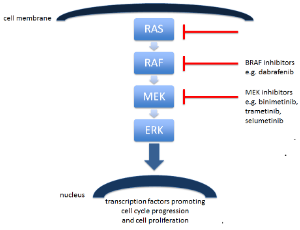
Autophagy: When to strike?
Shadi Zahedi, Jean M. Mulcahy Levy
Autophagy was originally viewed as a widely conserved multistep lysosomal degradation pathway in eukaryotes. It includes the formation of autophagosomes, doublemembrane structures engulfing cytoplasm with damaged organelles during the degradation process.
J Cancer Immunol, 2020, Volume Volume 2, Issue Issue 1, p13-16 | DOI: 10.33696/cancerimmunol.2.008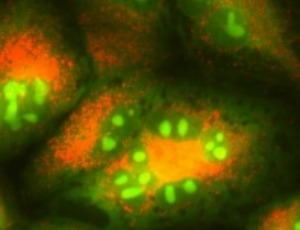
Small-molecule Interferon Inducers for Cancer Immunotherapy Targeting Non-T cell-inflamed Tumors
Eunha Kim, Sanghee Lee
Since the discovery of escaping mechanism of tumor from negative immune regulation, the paradigm of drug discovery for anti-cancer agents has been dramatically shifted to cancer immunotherapy (e.g., dendritic cell therapy, CAR-T cell therapy, or antibody therapy) by stimulating patient’s immune system to treat cancer.
J Cancer Immunol, 2021, Volume Volume 3, Issue Issue 1, p13-17 | DOI: 10.33696/cancerimmunol.3.037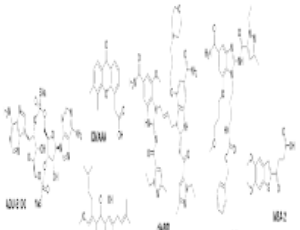
Insights from Long Noncoding RNAs into Cancer-immunity Cycle Regulation
Ye-Lin Liang, Yuan Zhang, Xi-Rong Tan, Han Qiao, Jun Ma, Ying-Qin Li, Na Liu
Accumulating evidence from recent research offers new perspectives on the functions of long non-coding RNAs (lncRNAs) in immunooncology. In addition to modulating the aggressiveness of cancer cells, lncRNAs are essential players in regulating various immune cells and stromal cells, playing a role in reshaping the tumor microenvironment and affecting anti-tumor immunity.
J Cancer Immunol, 2023, Volume Volume 5, Issue Issue 1, p13-28 | DOI: 10.33696/cancerimmunol.5.073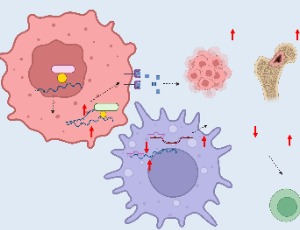
Role of a Training Simulator for Kidney Biopsy and Tumor Removal Procedures in Complex Positioning Scenarios: The Key Challenges
Trijit Reet Adhikary, Santu Paul, Anu Jayanthi Panicker, Sarada Prasad Dakua
Preventable medical errors and iatrogenic injuries remain significant contributors to mortality and morbidity, emphasizing the need for effective clinical training methodologies. Traditional teaching methods often inadequately prepare physicians for mastering procedural skills. Surgical procedures like nephrectomy for kidney tumor removal require intricate understanding of renal anatomy and meticulous technique. Close coordination among the specialists remains crucial to ensure optimal patient outcomes.
J Cancer Immunol, 2024, Volume Volume 6, Issue Issue 1, p14-19 | DOI: 10.33696/cancerimmunol.6.079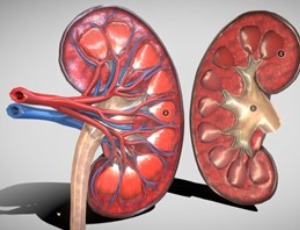
Immunotherapy in MSS/pMMR Metastatic Colorectal Cancer – Insights from the KEYNOTE-651
Ruoyu Miao, Richard D. Kim
Microsatellite stable (MSS)/mismatch repair-proficient (pMMR) colorectal cancer (CRC) accounts for the majority of CRC cases and generally respond poorly to immunotherapy alone. This mini-review integrates findings from the KEYNOTE-651 study with current knowledge of frontline immunotherapy in MSS/pMMR metastatic CRC and explores the implications for clinical practice and future research directions.
J Cancer Immunol, 2025, Volume Volume 7, Issue Issue 1, p15-19 | DOI: 10.33696/cancerimmunol.7.100
Combination Therapies with Anti-angiogenesis and B7-H3 Blockade in Cancers
Ruoqin Wang, Tongguo Shi, Weichang Chen
Tumor angiogenesis, a hallmark of cancer, is a critical step in the tumorigenesis of solid cancers. The process of tumor angiogenesis is orchestrated by a range of secreted factors, signaling pathways as well as nonendothelial cells.
J Cancer Immunol, 2020, Volume Volume 2, Issue Issue 1, p17-21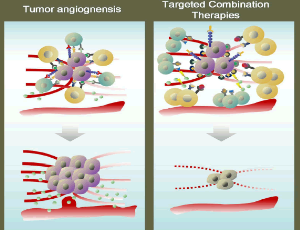
Cancer-Related Pain: Inside a New Dynamic Personalized Approach. A Narrative Review
Mariateresa Giglio, Giustino Varrassi, Filomena Puntillo
Chronic cancer-related pain, according to the latest International Classification of Diseases (ICD-11), is defined as “chronic pain caused by the primary cancer itself or metastases (chronic cancer pain) or its treatment (chronic post-cancer treatment pain)”.
J Cancer Immunol, 2022, Volume Volume 4, Issue Issue 1, p17-21 | DOI: 10.33696/cancerimmunol.4.060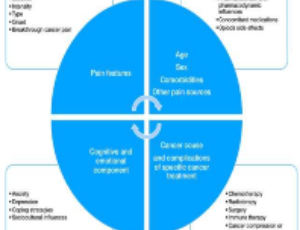
SHP2 Inhibition as a Promising Anti-cancer Therapy: Function in Tumor Cell Signaling and Immune Modulation
Jiawan Wang, Lindy Zhang, Christine A. Pratilas, Nicolas J. Llosa
The protein tyrosine phosphatase SHP2, encoded by PTPN11, functions as a critical signal transduction regulator and interacts with key signaling molecules in both RAS/ERK and PD-1/PD-L1/ BTLA (B- and T-lymphocyte attenuator) pathways. Targeting SHP2 pharmacologically, therefore, may be a promising therapeutic strategy for many RAS-driven cancers.
J Cancer Immunol, 2021, Volume Volume 3, Issue Issue 1, p18-29 | DOI: 10.33696/cancerimmunol.3.038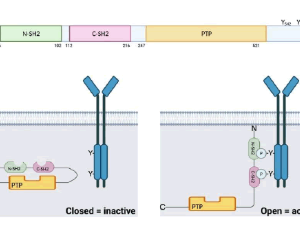
Enhancing the Efficacy of CAR-T Cell Therapy: A Comprehensive Exploration of Cellular Strategies and Molecular Dynamics
Mehmet A. Baysal, Abhijit Chakraborty, Apostolia M. Tsimberidou
The emergence of chimeric antigen receptor T cell (CAR-T cell) therapy has revolutionized cancer treatment, particularly for hematologic malignancies. This commentary discusses developments in CAR-T cell therapy, focusing on the molecular mechanisms governing T cell fate and differentiation. Transcriptional and epigenetic factors play a pivotal role in determining the specificity, effectiveness, and durability of CAR-T cell therapy.
J Cancer Immunol, 2024, Volume Volume 6, Issue Issue 1, p20-28 | DOI: 10.33696/cancerimmunol.6.080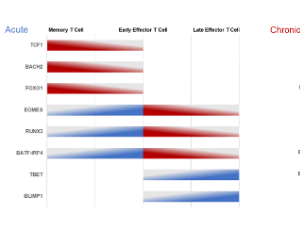
Mechanisms and Clinical Implications of Immune Checkpoint Inhibitors PD-1, CTLA-4, and TIM-3 in Cancer
Jordan T. Bruner, Joseph D. Cozis, Austin J. Marrah, Trent G. Mayberry, Braydon B. Cowan, Mark R. Wakefield, Yujiang Fang
Cancer poses a significant health challenge due to its complex nature and the limitations of current treatments. Over the last decade, emerging research has identified that modulation of immune checkpoint molecules such as CTLA-4, PD-1, and TIM-3 can have potential therapeutic benefits. These molecules are critical regulators of the immune system’s ability to target and eliminate cancer cells. This review explores the roles of these immune checkpoints in cancer and hematological malignancies; examining their mechanisms of action and the potential they hold for enhancing therapeutic outcomes.
J Cancer Immunol, 2025, Volume Volume 7, Issue Issue 1, p20-29 | DOI: 10.33696/cancerimmunol.7.101
Emerging Potential of Plant Virus Nanoparticles (PVNPs) in Anticancer Immunotherapies
Mehdi Shahgolzari, Steven Fiering
Plant virus nanoparticles (PVNPs) are increasingly recognized and studied for use in biomedical applications. PVNPs include plant virions with self-assembled capsid protein coats (PC) that encapsulate the virus genome, and virus-like particles (VLPs), a capsid without the viral genome.
J Cancer Immunol, 2022, Volume Volume 4, Issue Issue 1, p22-29 | DOI: 10.33696/cancerimmunol.4.061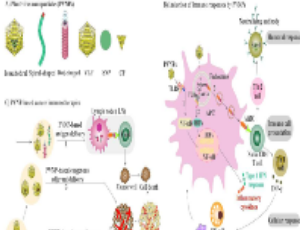
Relationship of lncRNA to Breast Cancer
Alpizar-Reyes B, Barrera-Tamariz MR, Contreras-Gómora I, Munguia-Arriaga MA, Ávila-Avilés RD
At present, breast cancer is more frequently diagnosed in women than in men. According to global cancer statistics, each year more than 1,675,000 women are diagnosed and more than 500,000 of them die. Some subtypes of breast cancer have been described.
J Cancer Immunol, 2020, Volume Volume 2, Issue Issue 1, p22-34 | DOI: 10.33696/cancerimmunol.2.010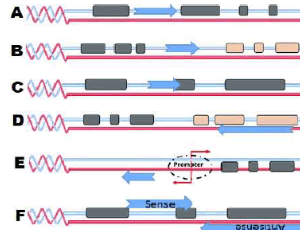
Salivary Protein Antigens for Breast Cancer Biomarkers
Imad Abrao Nemeir, Joseph Saab, Walid Hleihel, Abdelhamid Errachid, Nadia Zine
Breast Cancer is the most regularly diagnosed type of cancer in women in the world, making up on its own 25% of all cases, or nearly 2 million new cases in 2018, and 15% of all cancer related deaths, or around 626,700 deaths for that same year.
J Cancer Immunol, 2019, Volume Volume 1, Issue Issue 1, p24-30 | DOI: 10.33696/cancerimmunol.1.004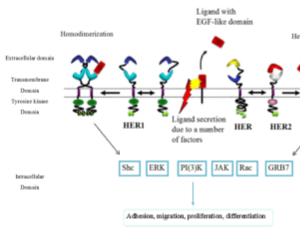
Negative Feedback Expansion of Tregs Caused by Endogenous IL-2 Limits the Activity of IL-2-based Therapies
Inbar Amit, Natalie Levitin, Meital Gadrich, May Ben-Mayor, Timothy Wyant, Reut Barak, Liron Danielpur, Morya Ifrach, Itzhak Meir, Olga Bluvshtein, Yehezkel Sasson, Sharon Fischman, Guy Nimrod, Michael Zhenin, Yair Fastman, James Vasselli, Aron Knickerbocker, Ronald Herbst, Yanay Ofran
Stimulating effector T-cells (Teffs) without inducing regulatory T-cells (Tregs) has been the primary goal of IL-2-based therapies for cancer. Recently, modified IL-2 designed for differential T-cell expansion for the treatment of cancer has failed in the clinic. We propose that treatments based on exogenous administrations of modified IL-2 are inherently undermined by a negative feedback loop, caused by IL-2 secreted endogenously from activated effector T-cells.
J Cancer Immunol, 2023, Volume Volume 5, Issue Issue 1, p29-39 | DOI: 10.33696/cancerimmunol.5.074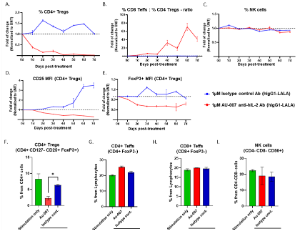
- Abstract |
- Full Text |
- Cite |
- Supplementary File
Perioperative Immune Checkpoint Blockade for Muscle-Invasive and Metastatic Bladder Cancer
Chethan Ramamurthy, Karen M. Wheeler, Shaun Trecarten, Zaineb Hassouneh, Niannian Ji, Yifen Lee, Robert S. Svatek, Neelam Mukherjee
Checkpoint inhibitors offer promise in treating muscle-invasive and metastatic bladder cancer, but the optimal timing of their administration—neoadjuvant or adjuvant—remains unclear. To determine the efficacy of combining checkpoint inhibition with standard cisplatin-based chemotherapy, we conducted a phase II trial of neoadjuvant anti-PD-1 (αPD-1) and anti-CTLA-4 (αCTLA-4), in combination with cisplatin-gemcitabine, for patients with muscle-invasive bladder cancer prior to radical cystectomy.
J Cancer Immunol, 2024, Volume Volume 6, Issue Issue 1, p29-39 | DOI: 10.33696/cancerimmunol.6.081
- Abstract |
- Full Text |
- Cite |
- Supplementary File
OGR1-a Novel Modulator Target of Tumor Immunotherapy
Guoxin Zhang, Ran Gao
Tumors mainly utilize glucose to promote aerobic glycolysis for their survival (Warburg effect). The highly glycolytic environment is not suitable for the survival and function of effector T cells, and leads to the decline of antitumor immunity.
J Cancer Immunol, 2022, Volume Volume 4, Issue Issue 1, p30-32 | DOI: 10.33696/cancerimmunol.4.062
Expanding the Cancer Neoantigen Peptide Repertoire beyond In silico Tools
Amit Jain, Jackwee Lim
CD8+ cytotoxic T cells recognise and kill cancer cells that present immunogenic peptides bound to the cell surface major histocompatibility complex class I (MHC-I) molecules.
J Cancer Immunol, 2021, Volume Volume 3, Issue Issue 1, p30-36 | DOI: 10.33696/cancerimmunol.3.039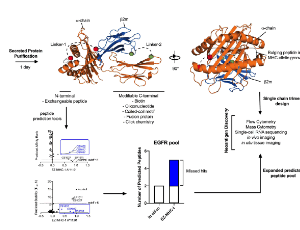
Sexual Dimorphism in Immunity and Metabolism: Unraveling the Impact on Response to Cancer Immunotherapy
Adam C. Soloff, Hannah M. Udoh, Charles E. Bardawil, Xinyue Zhao, Laura P. Stabile
A recent observational study by Jin et al., found male sex and pretreatment weight loss to be associated with worse progression free survival (PFS) and overall survival (OS) in non-small cell lung cancer (NSCLC) patients treated with immune checkpoint inhibition (ICI) [1]. Although sexual dimorphism in immunity is well established, recent studies have begun to elucidate the mechanisms by which sex-specific immunity contributes to diseases such as cancer, and autoimmunity [2-5]. Similarly, the complex interplay between gonadal hormones, sex-based gene expression, and metabolism, particularly immunometabolism and the subsequent ability to mount effective antitumor immunity is a burgeoning field of investigation.
J Cancer Immunol, 2025, Volume Volume 7, Issue Issue 1, p30-38 | DOI: 10.33696/cancerimmunol.7.102
Commentary on "The Gene Master Regulators GMR Approach Provides Legitimate Targets for Personalized, Time-Sensitive Cancer Gene Therapy"
Dumitru Andrei Iacobas
For decades, the scientific community tried hard to identify the gene biomarkers whose mutations or regulations cause (better say are associated with) specific forms of cancer. For instance, the September 17th 2019 release of the Genomic Data Commons Data Portal includes 3,142,246 mutations detected in 22,872 genes sequenced from 37,075 cases of cancers localized in 67 primary sites.
J Cancer Immunol, 2019, Volume Volume 1, Issue Issue 1, p31-33 | DOI: 10.33696/cancerimmunol.1.005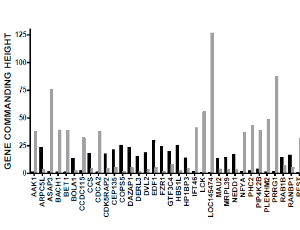
Higher Frequency and Poor Prognosis with COVID-19 Associated Cytokine Storm among Cancer Patients: Between Two Fires
Murat Bektaş, Nevzat Koca, Burak İnce
At the end of 2019, the world faced a new disease, COVID-19 caused by SARS-Cov-2 and became a pandemic within few weeks. The fact that COVID-19 spreads very quickly and has
significant morbidity and mortality had devastating effects all over the world.
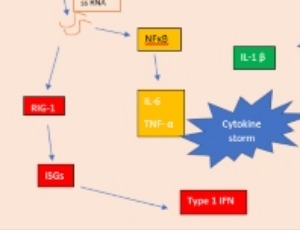
Artificial Intelligence and Machine Learning in Cancer Care: Current Applications and Future Perspectives
Sachin Kumar Deshmukh
Cancer is the second most common cause of death worldwide, accounting for an estimated 9.6 million deaths in the year 2018, a number that is expected to grow to more than 13 million by 2030. In the past decade, we have witnessed unprecedented scientific advancement in the understanding of cancer etiology, prevention, diagnosis and development of new therapeutic strategies.
J Cancer Immunol, 2020, Volume Volume 2, Issue Issue 2, p35-36 | DOI: 10.33696/cancerimmunol.2.011
Aerosol Distribution Pattern of a Single-port Device: New Perspective Treatment for Peritoneal Carcinomatosis in Brazil
Rafael Seitenfus, Lívia Brancher Gravina, Gustavo Andreazza Laporte
The local and peritoneal recurrence play a vital role in the natural history of the evolution of gastrointestinal and ovarian neoplasms. Different methods of applying intraperitoneal chemotherapy were used perioperatively to consolidate or control peritoneal carcinomatosis [1]. The use of chemotherapy directly in the peritoneal cavity allows the direct action of the therapeutic agent in the metastatic nodules, increasing the local concentration with a limited increase in the systemic concentration.
J Cancer Immunol, 2020, Volume Volume 2, Issue Issue 2, p37-39 | DOI: 10.33696/cancerimmunol.2.012
Lenalidomide Maintenance After Autologous Stem Cell Transplant: The Utility of Real-World Data and Future Areas of Study
Hannah M Cherniawsky, Christopher P Venner, Esther Masih-Khan, Donna Reece
Low-dose, lenalidomide maintenance following autologous stem cell transplantation (ASCT) is the current standard of care in patients with newly diagnosed multiple myeloma (NDMM) based on results from large, randomized controlled trials and a meta-analysis which demonstrated improved overall (OS) and progressionfree survival (PFS).
J Cancer Immunol, 2021, Volume Volume 3, Issue Issue 1, p37-46 | DOI: 10.33696/cancerimmunol.3.040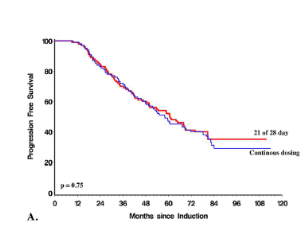
Epigenetic Reprogramming with DNMT Inhibitors: A Multi-Mechanistic Approach to Enhance Immunotherapy in Glioblastoma
Thomas J. Lai, Robert M. Prins, Richard G. Everson
Although adoptive T cell therapies and immune checkpoint blockades have been successfully implemented in various cancers, no immunotherapy agents have yet reached FDA approval for glioblastoma (GBM). GBM harbors a uniquely immunosuppressive tumor microenvironment that presents significant barriers to effective immunotherapy. Key hallmarks of the GBM microenvironment include the exclusion of lymphoid cells from the tumor core and the predominance of immunosuppressive tumor-associated macrophages .
J Cancer Immunol, 2025, Volume Volume 7, Issue Issue 1, p39-44 | DOI: 10.33696/cancerimmunol.7.103
Protein Therapeutics from Monolayer to Spheroids- A Model for Preclinical Investigations
Neha Arora, Siddhartha Sankar Ghosh
The arrival of recombinant insulin in the pharmaceutical market paved a new direction for the clinical potential of proteins. Thus, the pharmaceutical industry underwent a paradigm shift towards proteins as therapeutic moieties. A number of recombinant protein drugs are available and many more are in pipeline to target major diseases, such as cancer, viral diseases, cardiovascular diseases and endocrine disease.
J Cancer Immunol, 2020, Volume Volume 2, Issue Issue 2, p40-43 | DOI: 10.33696/cancerimmunol.2.013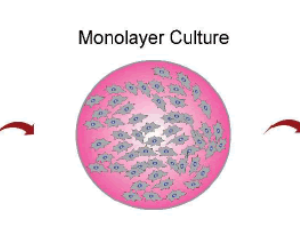
Aromatase Inhibitors and their Connection to Autoimmunity
Savannah Bowman, Carlos H Barcenas, Huifang Lu
The aromatase inhibitors (AIs) anastrozole, letrozole, and exemestane are often prescribed as endocrine therapy for patients with estrogen receptor–positive breast cancer. AIs are associated with musculoskeletal side effects such as bone loss, arthralgias, myalgias, and tenosynovitis. Notably, exemestane is a steroidal AI and both anastrozole and letrozole are non-steroidal AIs.
J Cancer Immunol, 2024, Volume Volume 6, Issue Issue 1, p40-43 | DOI: 10.33696/cancerimmunol.6.082
Epithelial Mesenchymal Transition: The Ultimate Driver of Cancer on Difficult Paths
Devavrat Tripathi, Pramod Kumar Gupta, Savita Kulkarni
Metastasis is the perilous aspect of cancer and is responsible for 90% of deaths due to cancer. It represents an enigmatic and complex biological cascade that is poorly understood. The constant development in cancer research and the advent of new principles in metastasis have discovered some of the molecular keystones like epithelial-mesenchymal transition (EMT) and cancer stem cells (CSCs) of this cascade.
J Cancer Immunol, 2023, Volume Volume 5, Issue Issue 1, p40-60 | DOI: 10.33696/cancerimmunol.5.075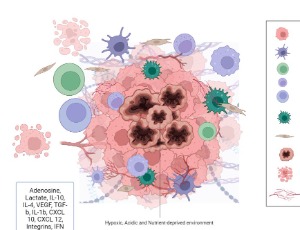
Can Butein be a Future Candidate for the Treatment of Advance Metastatic Thyroid Cancer?
Devavrat Tripathi, Savita Kulkarni
The incidence and prevalence of papillary thyroid cancer (PTC) are increasing worldwide and it is the 5th most common endocrine cancer in females.
J Cancer Immunol, 2022, Volume Volume 4, Issue Issue 2, p43-46 | DOI: 10.33696/cancerimmunol.4.064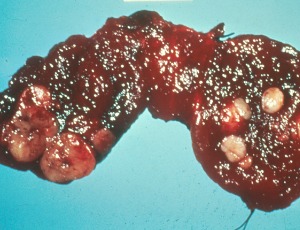
AMBRA1: Orchestrating Cell Cycle Control and Autophagy for Cellular Homeostasis
Yang Wang, Goran Stjepanovic
The Activating Molecule in Beclin-1-Regulated Autophagy (AMBRA1) is a scaffold protein involved in many cellular processes, including autophagy, apoptosis, cell growth and development. AMBRA1 functions as a substrate receptor of the DDB1-Cullin4-RBX1 ubiquitin E3 ligase complex that plays key roles in autophagy and the cell cycle regulatory network. Considering the crucial role of AMBRA1 in cellular homeostasis, structural and functional studies are important for understanding the mechanisms that coordinate these cell responses.
J Cancer Immunol, 2024, Volume Volume 6, Issue Issue 1, p44-50 | DOI: 10.33696/cancerimmunol.6.083
Verrucous Carcinoma of the Esophagus: Its Unique Etiology and Association with Human Papilloma Virus
Satoshi Tabuchi, Kazuo Koyanagi, Soji Ozawa, Shigeyuki Kawachi
Verrucous carcinoma of the esophagus (VCE) is a rare variant of esophageal squamous cell carcinoma. Most cases of VCE presents as an exophytic, slow-growing mass with a superficial growth pattern. Even when VCE exhibits a characteristic pattern during an endoscopic examination, it is very difficult to make a definitive diagnosis of VCE preoperatively, because biopsy specimens are
only characterized by nonspecific acanthosis and hyperkeratosis or parakeratosis associated with inflammation.
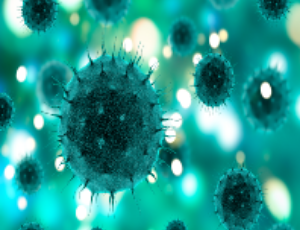
Role of Exogenous HSPB1 in Cytokine Regulation Through TLR2, TLR4, TLR5, TLR7, and MyD88/MAPK p38/NF-κB Pathways in Differentiated THP-1 Cells
Rajah Khaouader Essalemi, Emmanuel Ogbodo, Nusrat Jahan Hoque, Chelsea R Wood, Hend Moosa
The modulation of the innate immune system has been a significant area of interest in research, as it represents the body’s first line of defense against pathogens. Heat shock proteins (HSPs), particularly small HSP, like HSPB1 (HSP27), are emerging as potent therapeutic options for preventing and managing inflammatory conditions due to their ability to modulate the immune system.
J Cancer Immunol, 2025, Volume Volume 7, Issue Issue 2, p45-59 | DOI: 10.33696/cancerimmunol.7.104
Performance of the Tyrer-Cuzick 8 Breast Cancer Risk Model Across Races: A Review
Melissa D Porterhouse, Rosalinda Alvarado
The Tyrer-Cuzick (TC) model is a breast cancer risk assessment tool that provides women with their risk of developing breast cancer based on genetic and personal factors. The most recent version of the TC model, TC8, is the first version to include breast density as a risk factor for breast cancer.
J Cancer Immunol, 2022, Volume Volume 4, Issue Issue 2, p47-51 | DOI: 10.33696/cancerimmunol.4.065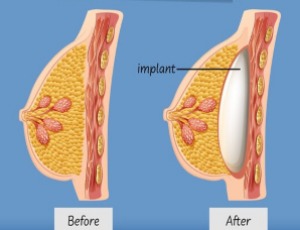
Immunogenic Cell Death: A Step Ahead of Autophagy in Cancer Therapy
Gourab Gupta, Kristina Borglum, Hexin Chen
Cell Death has long been considered to be an inevitable part of the life cycle of a cell and hence, considered a familiar consequence of cellular life.
J Cancer Immunol, 2021, Volume Volume 3, Issue Issue 1, p47-59 | DOI: 10.33696/cancerimmunol.3.041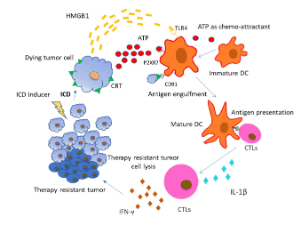
Unlocking Biomarkers for Cancer Immunotherapy: Immune Monitoring with High-Parameter Flow Cytometry
Xiyu Peng, Fiona Ehrich, Ronglai Shen, Panageas Katherine
A decade ago, Science magazine named cancer immunotherapy as the breakthrough of the year, recognizing its pivotal clinical trials of antibodies designed to inhibit negative regulators of T cell function. Antibody therapies targeting cytotoxic T lymphocyte antigen 4 (CTLA-4) and programmed cell protein 1 (PD-1) initially showed effectiveness against advanced melanoma and have since expanded in use to non-small cell lung, renal cell, and bladder cancers, among others.
J Cancer Immunol, 2024, Volume Volume 6, Issue Issue 2, p51-54 | DOI: 10.33696/cancerimmunol.6.084
Involvement of D-Loop Mutations in the Occurrence of Ovarian Carcinoma
Oumar Mane, Fatimata Mbaye, Mbacké Sembene
Cancer mortality is proportionally higher in Africa than elsewhere in the world. In Senegal, ovarian cancer is responsible for 2.8% of deaths and is one of the most fatal gynaecological cancers. This work is therefore being carried out in order to better understand the impact of D-Loop mutations in the evolution of ovarian cancer in Senegalese women.
J Cancer Immunol, 2020, Volume Volume 2, Issue Issue 2, p52-59 | DOI: 10.33696/cancerimmunol.2.015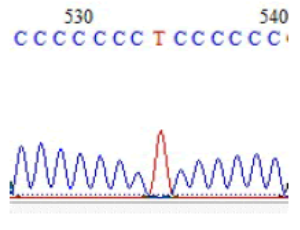
Clutch Control: Changing the Speed and Direction of CAR-T Cell Therapy
Alberto Nobili, Aya Kobayashi, Patrick C. Gedeon, Carl D. Novina
The adoptive transfer of T cells expressing chimeric antigen receptors (CAR-T cells) has revolutionized the treatment of hematological malignancies, providing unmatched clinical responses in adults and children with relapsed or refractory B cell malignancies.
J Cancer Immunol, 2022, Volume Volume 4, Issue Issue 2, p52-59 | DOI: 10.33696/cancerimmunol.4.066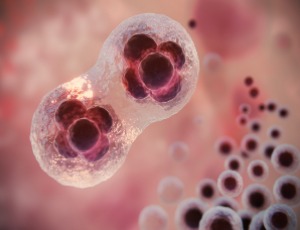
Commentary on the Volume-Outcome Relationship in CRS/HIPEC for Peritoneal Carcinomatosis
Stephanie N Gregory, Praveen D Chatani, Henry A Pitt, H Richard Alexander
Peritoneal carcinomatosis historically has a poor prognosis; however, Cytoreductive Surgery (CRS) and Hyperthermic Intraperitoneal Chemotherapy (HIPEC) have shown improved outcomes. While a volume-outcome relationship is established in oncologic surgeries, its applicability to CRS/HIPEC remains unexplored. This study examines the impact of hospital volume on CRS/HIPEC outcomes.
J Cancer Immunol, 2024, Volume Volume 6, Issue Issue 2, p55-61 | DOI: 10.33696/cancerimmunol.6.085
Cellular Response to Stress: At the Crossroads between Immunosenescence and Cancer
Christian R. Gomez
Aging is a complicated process not yet fully understood. Driven by a variety of stressors such as infectious agents, radiation, intracellular stress, and stressing metabolic conditions, molecular damage occurs over time [1]. Among many consequences, age-related unchecked molecular damage leads to immunosenescence, a hallmark of aging. Traditionally defined as a declining function of the immune system, immunosenescence is a term that includes the effect of aging on adaptive and innate immunity [2].
J Cancer Immunol, 2020, Volume Volume 2, Issue Issue 3, p60-61 | DOI: 10.33696/cancerimmunol.2.016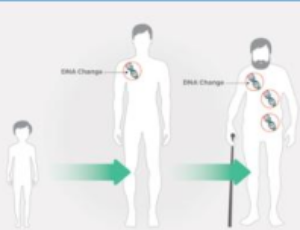
Molecular Iodine Misconceptions: A Novel Formulation Approach to Topical Iodine
Jack Kessler
My team of chemists have formulated molecular iodine (I2) so it can be studied independent of other iodine species.The initial impetus for this effort was to allow for a higher concentration of biocidal I2 that would not evaporate into the atmosphere when applied to skin.
J Cancer Immunol, 2022, Volume Volume 4, Issue Issue 2, p60-64 | DOI: 10.33696/cancerimmunol.4.067
Hepatocellular Carcinoma: Diagnosis, Therapy and Molecular Investigations
Veronica Bazzani, Riccardo Pravisani, Umberto Baccarani, Carlo Vascotto
Hepatocellular carcinoma (HCC) accounts for approximately 90% of primary liver cancers and, with rapidly increasing incidence in the last two decades, constitutes a major global health problem.
J Cancer Immunol, 2021, Volume Volume 3, Issue Issue 1, p60-65 | DOI: 10.33696/cancerimmunol.3.042
Role of Exogenous HSPA1A in Cytokine Regulation Through TLR2, TLR4, TLR5, TLR7, and MyD88/MAPK p38/NF-κB Pathways in Differentiated THP-1 Cells
Nusrat Jahan Hoque, Emmanuel Ogbodo, Rajah Khaouader Essalemi, Chelsea R Wood, Hend Moosa
Heat shock proteins (HSPs) are ubiquitous proteins that play an important role in cellular stress responses, contributing to immune activation through interactions with toll-like receptors (TLRs) and other pattern recognition receptors. Despite extensive research, the exact mechanism by which HSPs modulate immune responses is still unclear. This study explores the immune-modulatory role of HSPA1A by examining its effect on cytokine production in PMA-differentiated THP-1 macrophages, preincubated with TLR-specific blocking peptides prior to exposure to recombinant HSPA1A.
J Cancer Immunol, 2025, Volume Volume 7, Issue Issue 2, p60-71 | DOI: 10.33696/cancerimmunol.7.105
Emulating the Role of Neutrophils in Head and Neck Cancer Microenvironment: Prognostic Role and Therapeutic Strategies
Khushwant Singh, Pramod kumar Gautam
Head and neck squamous cell carcinoma (HNSCC) are a group of cancers that affect various parts of the head and neck, such as the lip, oral cavity, oropharynx, hypopharynx, and nasopharynx. In India, it accounts for approximately 30–40% of all cancers, while in the United States, it represents around 4% of all cancer cases. HNSCC is a significant contributor to cancer-related deaths globally. While smoking is linked to HNSCC
J Cancer Immunol, 2023, Volume Volume 5, Issue Issue 2, p61-73 | DOI: 10.33696/cancerimmunol.5.076
Purinergic System and Cervical Cancer: Perspectives
Marta Schmidt Pfaffenzeller, Maria Luiza Mukai Franciosi, Adriana Fuganti Wagner, Andreia Machado Cardoso
We have recently published an article entitled “Purinergic signaling and tumor microenvironment in cervical Cancer”. In this paper, we reviewed the last studies about purinergic signaling and cervical cancer, highlighting the intrinsic factors related to the inflammatory process, such as extracellular nucleotides and adenosine - components of the purinergic system.
J Cancer Immunol, 2020, Volume Volume 2, Issue Issue 3, p62-65 | DOI: 10.33696/cancerimmunol.2.017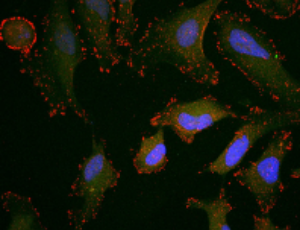
Combining EGFR and KRAS G12C Inhibitors for KRAS G12C Mutated Advanced Colorectal Cancer
Hirotaka Miyashita, David S. Hong
KRAS is a commonly mutated gene in advanced colorectal cancer (CRC). Recently, inhibitors of KRAS G12C were developed and have shown promising efficacy for KRAS G12C mutated non-small cell lung cancer. However, KRAS G12C inhibitor monotherapy has not demonstrated excellent efficacy for KRAS G12C mutated advanced CRC due to multiple resistance mechanisms, especially receptor tyrosine kinase (RTK) signaling activation.
J Cancer Immunol, 2024, Volume Volume 6, Issue Issue 2, p62-69 | DOI: 10.33696/cancerimmunol.6.086
A Surprising Benefit of Cysteine Capping for Antibody Drug Conjugates
Aaron M. D’Antona, Kaushik Dutta, Xiaotian Zhong
Antibody-drug conjugates (ADCs), combining the best features of monoclonal antibodies and small molecule drugs, are considered the “guided missiles” for cancer therapy, with eleven FDA-approved products. Yet the ADC modality still presents a huge challenge to drug developers, especially for targeting tumors with low abundance and/or heterogeneity of tumor-associated antigens.
J Cancer Immunol, 2022, Volume Volume 4, Issue Issue 2, p65-70 | DOI: 10.33696/cancerimmunol.4.068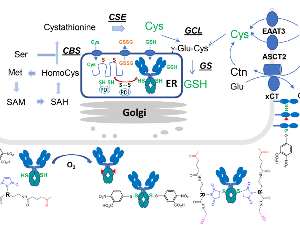
Inference of Clonal Copy Number Alterations from RNASequencing Data
Akdes Serin Harmanci, Arif O. Harmanci, Xiaobo Zhou
Tissues are composed of various types of interacting cells [1]. To understand the cellular organization and function in tissues, it is necessary to identify all of the different cell types and the locations of these different cell types within tissue structures. The transformative advances in experimental and computational methods will help us to build the complex map of the tissues and study how tissue organization influences the cell’s molecular state and interactions in healthy and diseased tissue.
J Cancer Immunol, 2020, Volume Volume 2, Issue Issue 3, p66-68 | DOI: 10.33696/cancerimmunol.2.018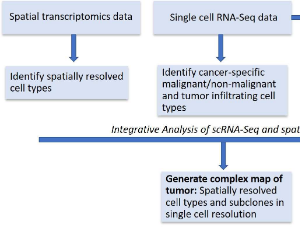
Inhibition of Autophagy and Immune Response: Alpha-fetoprotein Stimulates Initiation of Liver Cancer
Mingyue Zhu, Mengsen Li
Alpha-fetoprotein (AFP) is a tumorous marker for the diagnosis of hepatocellular carcinoma (HCC), it is synthesized mainly by the embryo yolk sac, fetal liver and the gastrointestinal tract. AFP belongs to the family of protein products of albuminoid genes, which are located in tandem arrangement in chromosome 4 (region 4q11-q13).
J Cancer Immunol, 2020, Volume Volume 2, Issue Issue 3, p69-73 | DOI: 10.33696/cancerimmunol.2.019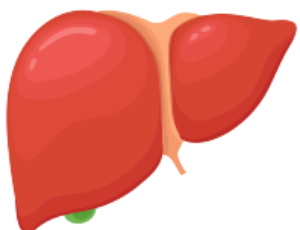
Tertiary Prevention and Treatment for Reducing Leukemia Relapse
Nikita Manyak, Mingyi Chen, Su Yon Jung
We have found little available information in the medical literature on the prevention and treatment of tertiary leukemia or patients' prognosis. We thus conducted a comprehensive literature review using the most recently updated American Society of Hematology guidelines, searching the MEDLINE and PubMed electronic databases by using the key term "progression-free survival (PFS) leukemia" and restricting results to the English language within the last decade.
J Cancer Immunol, 2024, Volume Volume 6, Issue Issue 2, p70-76 | DOI: 10.33696/cancerimmunol.6.087
Short Communication on HPV Infection, Pathogenesis of Cancer, Immune Cells Involved in Infection, Vaccination, and Suggested Treatments
Nika Nikmanesh, Ali Reza Safarpour, Ramin Niknam, Yousef Nikmanesh
Human Papillomavirus (HPV) is a common virus transmitted primarily through sexual contact. However, it can also be spread through other ways, such as pool water, contaminated personal items, and even from mother to infant during childbirth or breastfeeding. It infects the basal cells of the epidermis and replicates in differentiated cells. HPV infection is a global health concern linked to various cancers. This short communication explores HPV infections, genetic characteristics, immune interactions, and vaccines, aiming to provide a brief understanding of HPV and its associated diseases.
J Cancer Immunol, 2025, Volume Volume 7, Issue Issue 2, p72-80 | DOI: 10.33696/cancerimmunol.7.106
Prognostic Factors of Nintedanib-docetaxel in Patients with Previously Treated Non-small-cell Lung Cancer
Luis Cabezón-Gutiérrez, Sara Custodio-Cabello, Vilma Pacheco-Barcia, Magda Palka-Kotlowska, Catalina Saez-Bertrand, Marta Blasco-Guerrero
Background: In advanced non-small-cell lung cancer (NSCLC), second-line treatment with nintedanib plus docetaxel improves survival compared with docetaxel, especially in patients with adenocarcinoma histology who progressed within 9 months after the start of firstline treatment. It is therefore necessary to identify new biomarkers/prognostic factors that select the patients who benefit from this type of treatment.
J Cancer Immunol, 2023, Volume Volume 5, Issue Issue 2, p74-82 | DOI: 10.33696/cancerimmunol.5.077
Role of PD-L1 SP263 Assay in Cancer Immunotherapy: A Comprehensive Review
Trupti Pai, Hema Malini Aiyer, Bijal Kulkarni, Vidya MN, Shashikant C.U. Patne, Sandeep Sewlikar, Jayesh Deshmukh
Over the past decade, immune checkpoint inhibitors (ICIs) have transformed the treatment landscape for many types of cancers, leading to significant improvements in patient survival. Treatments like nivolumab, pembrolizumab, durvalumab, and atezolizumab have shown remarkable efficacy. Among the various biomarkers used to guide ICI therapy, PD-L1 is one of the most extensively studied. The PD-L1 SP263 assay is one of the most commonly used assays for identifying PD-L1 status.
J Cancer Immunol, 2024, Volume Volume 6, Issue Issue 2, p77-91 | DOI: 10.33696/cancerimmunol.6.088
Second-Line Systemic Therapies in Metastatic Renal Cell Carcinoma: Current Insights and Future Directions
Isaac E. Kim, Jr, Vivian Wong , Karie Runcie , Eric A. Singer
Over the past few decades, the incidence of renal cell carcinoma (RCC) has rapidly increased with a considerable portion of patients presenting with metastatic disease (mRCC) and subsequent poor prognosis. Survival drops even further for those whose diseases progress on first-line therapy including immune-checkpoint inhibitors (ICIs) and vascular endothelial growth factor receptor (VEGFR) tyrosine kinase inhibitors (TKIs). In this review, we highlight the main second-line systemic therapies including TKIs, mTOR inhibitors, ICIs, and HIF-2α inhibitors along with their mechanisms of action and supporting clinical trials.
J Cancer Immunol, 2025, Volume Volume 7, Issue Issue 2, p81-94 | DOI: 10.33696/cancerimmunol.7.107
Methylation Status of Tumor Suppressor Genes in Circulating DNA of PDAC Patients: Facts and Hopes
Bharti Garg, Nidhi Singh, Anoop Saraya
Pancreatic cancer is one of the most lethal solid tumor malignancies and it is projected to become a leading cause of cancer related deaths in coming years. It is often diagnosed at an advanced stage owing to the lack of specific symptoms and rapid invasion.
J Cancer Immunol, 2020, Volume Volume 2, Issue Issue 3, p85-95 | DOI: 10.33696/cancerimmunol.2.021
Cervical Cancer Prevalence in sub-Saharan Africa and HPV Vaccination Policy: A Public Health Grand Challenge?
Eric Asempah
“Women are not dying because of diseases we cannot treat. They are dying because societies have yet to make the decision that their lives are worth saving.”
J Cancer Immunol, 2021, Volume Volume 3, Issue Issue 2, p87-97 | DOI: 10.33696/cancerimmunol.3.043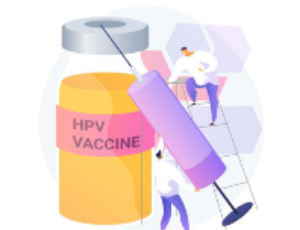
A Paradoxical AKT: Exploring the Promise and Challenges of PI3K/AKT/mTOR Targeted Therapies
Gennie L. Parkman, Sheri L. Holmen
Cutaneous melanoma, a malignancy originating from melanocytes in the skin, is challenging to treat due to its aggressive nature and propensity to metastasize. Despite the advancement of multifaceted treatment interventions, including targeted therapy, immunotherapy, and cellular therapy, the five-year-survival for patients with stage IV melanoma is only ~30% [1-3]. BRAF activating mutations are the most common genetic alteration in melanoma, comprising ~50% of all cutaneous melanoma cases [4,5].
J Cancer Immunol, 2024, Volume Volume 6, Issue Issue 3, p92-99 | DOI: 10.33696/cancerimmunol.6.089
Advanced Drug Delivery Systems in Dermatology and Cancer Immunotherapy: A Synthesis of Targeted Therapeutics and Immune Regulation
Ekta Yadav, MD, MBA, MS
Effective drug delivery to the skin or tumor microenvironment requires overcoming biological barriers while precisely modulating immune responses. In dermatology, topical therapies must penetrate the stratum corneum without triggering inflammation, whereas cancer immunotherapy demands targeted delivery to stimulate anti-tumor immunity with minimal off-target effects.
J Cancer Immunol, 2025, Volume Volume 7, Issue Issue 2, p95-98 | DOI: 10.33696/cancerimmunol.7.108
Progress in Diagnosis and Treatment of Immune Checkpoint Inhibitor-Associated Cardiotoxicity
Feng Wang, Shukui Qin
Immune checkpoint inhibitor (ICI)-associated cardiotoxicity is a rare immune-related adverse event with high mortality. In recent years, more and more reports were reported. It is urgent to improve understanding and management. Cardiac toxicity often occurs in the early stage after ICI treatment, and its clinical manifestations are diverse and nonspecific, and its pathogenesis is still unclear. Among them, the incidence of immune myocarditis is more than 1%, which can be manifested as fulminant, acute or chronic.
J Cancer Immunol, 2020, Volume Volume 2, Issue Issue 3, p96-102 | DOI: 10.33696/cancerimmunol.2.022
Exosomes, PD-L1 and aGvHD: Perspectives for WJMSCmediated Therapy
Meizhang Li, Haitham Abdelhakim, Mitchell W. Braun, Andrew K. Godwin
Tumor-derived small extracellular vesicles or exosomes which carry the checkpoint PD-L1 are directly involved in immune evasion and uncontrolled tumor growth. We have recently reported that PD-L1 is also enriched on Wharton’s Jelly Mesenchymal Stromal Cell (WJMSC)-associated exosomes.
J Cancer Immunol, 2021, Volume Volume 3, Issue Issue 2, p98-103 | DOI: 10.33696/cancerimmunol.3.044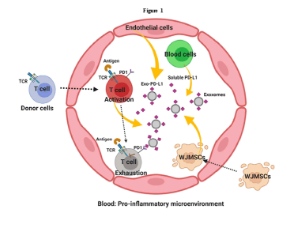
Targeting FAK to Potentiate Immune Checkpoint Therapy in Solid Tumors
Karly A. Stanley, Sheri L. Holmen
The advent of immune checkpoint inhibition revolutionized cancer care, yet many people will fail to respond due to innate or acquired resistance. Combination therapies with immune checkpoint inhibitors are being explored to enhance their efficacy and improve patient outcomes. Focal adhesion kinase (FAK), known for its roles in cell adhesion and migration, has emerged as a potential therapeutic target due to the identification of its additional functions in cancer progression, including its ability to establish a pro-tumorigenic, immunosuppressive microenvironment.
J Cancer Immunol, 2025, Volume Volume 7, Issue Issue 3, p99-108 | DOI: 10.33696/cancerimmunol.7.109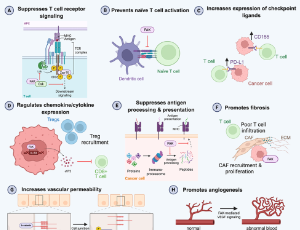
Cancer and Immune System: A Comprehensive Analysis of the General Patterns of Carcinogenesis
Oleksandr Shevchenko, Volodymyr Shevchenko
The proposed review reveals the pathogenesis of the malignant tumor process and the patterns of its initiation and development. It was established that the basis of the malignant tumor process is the physiological process of implantation of the embryo in the thickness of the decidual membrane of the uterus and the regulation of the invasive function of the trophoblast, created by evolution.
J Cancer Immunol, 2024, Volume Volume 6, Issue Issue 3, p100-115 | DOI: 10.33696/cancerimmunol.6.090
The Role of ERO1α in Modulating Cancer Progression and Immune Escape
Brennan D. Johnson, Werner J. Geldenhuys, Lori A. Hazlehurst
The failure to eradicate minimal residual disease often located at metastatic sites and/or the bone marrow niche continues to be a clinical barrier for successful treatments in cancer.
J Cancer Immunol, 2020, Volume Volume 2, Issue Issue 3, p103-115 | DOI: 10.33696/cancerimmunol.2.023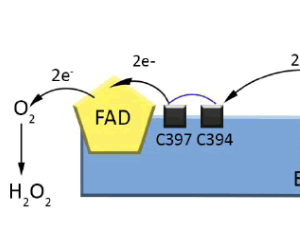
Emerging Roles of Pseudogene RNAs in Antitumor and Antiviral Immunity
Yoo Jane Han, Michaela U. Gack, Olufunmilayo I. Olopade
Tumor immunity and immunotherapy have become increasingly important in treatment strategies for a variety of malignancies including advanced triple negative breast cancer.
J Cancer Immunol, 2021, Volume Volume 3, Issue Issue 2, p104-110 | DOI: 10.33696/cancerimmunol.3.045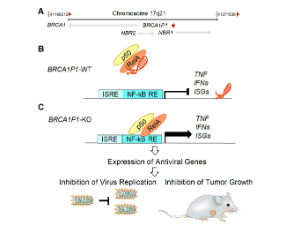
Adherent Natural Killer Cells De Novo Express IL-2Rα and Sustain Long-Lasting, Potent Anti-Tumor Activity in Picomolar Concentrations of IL-2
Nikola L. Vujanovic, Lazar Vujanovic, Theresa L. Whiteside
Natural killer (NK) cells are innate lymphoid cells (ILCs) that play key roles in immunosurveillance and immunoregulation. They constitute a heterogeneous population comprising three principal subpopulations: NK1 (cytotoxic), NK2 (regulatory), and NK3 (adaptive). In response to interleukin-2 (IL-2) stimulation, NK3 cells differentiate into adherent NK (A-NK) cells, which exhibit potent anti-tumor activity. Human A-NK cells are generated by priming and adherence-based selection of peripheral blood NK3 cells in nanomolar (nM) IL-2 concentrations, followed by prolonged restimulation and culture in the same IL-2 conditions.
J Cancer Immunol, 2025, Volume Volume 7, Issue Issue 3, p109-122 | DOI: 10.33696/cancerimmunol.7.110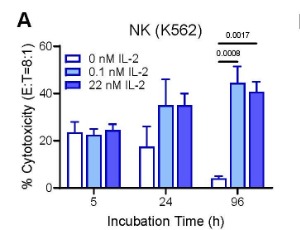
- Abstract |
- Full Text |
- Cite |
- Supplementary File
Relevance of Neuropilin 1 and Neuropilin 2 Targeting for Cancer Treatment
Aurore Dumond, Gilles Pagès
Neuropilins (NRPs) are a class of transmembrane glycoprotein co-receptors including Neuropilin 1 (NRP1) and Neuropilin 2 (NRP2). They are the co-receptors of different families of receptors, thus they are involved in many hallmarks of cancer.
J Cancer Immunol, 2021, Volume Volume 3, Issue Issue 2, p111-114 | DOI: 10.33696/cancerimmunol.3.046
Immune Checkpoint Inhibitors in the Management of Urothelial Carcinoma
Aakash Patel, Daniel I. Bisn, Hiren V. Patel, Saum Ghodoussipour, Biren Saraiya, Tina Mayer, Eric A. Singer
Bladder cancer is one of the most common and expensive cancers in the United States, with an expected 81,400 new cases and 17,980 deaths in 2020 alone. The incidence is increased among white men and diagnoses often occur in the 7th decade of life.
J Cancer Immunol, 2021, Volume Volume 3, Issue Issue 2, p115-136 | DOI: 10.33696/cancerimmunol.3.047
Commentary: Next Generation Sequencing (NGS) of Matched Tissue and Circulating DNA (ctDNA) in Patients with Squamous Cell Carcinoma of the Head and Neck (SCCHN)
Panagiota Economopoulou, Ioannis Kotsantis, Amanda Psyrri
Despite advances in multimodality treatment, a significant proportion of patients with squamous cell carcinoma of the head and neck (SCCHN) eventually presents with either local recurrence or distant metastases. Although imaging and tissue biopsy are the cornerstones for the diagnosis of relapse, tissue acquisition is impeded by the complex anatomy of head and neck tumors which frequently necessitates open biopsies via examination under anesthesia; therefore, understanding the underlying molecular biology is challenging.
J Cancer Immunol, 2024, Volume Volume 6, Issue Issue 3, p116-118 | DOI: 10.33696/cancerimmunol.6.091
Immunological Features with DNA Microsatellite Alterations in Patients with Colorectal Cancer
Maide Ö. Raeker, John M. Carethers
Competent human DNA mismatch repair (MMR) corrects DNA polymerase mistakes made during cell replication to maintain complete DNA fidelity in daughter cells; faulty DNA MMR occurs in the setting of inflammation and neoplasia, creating base substitutions (e.g. point mutations) and frameshift mutations at DNA microsatellite sequences in progeny cells. Frameshift mutations at DNA microsatellite sequences are a detected biomarker termed microsatellite instability (MSI) for human disease, as this marker can prognosticate and determine therapeutic approaches for patients with cancer.
J Cancer Immunol, 2020, Volume Volume 2, Issue Issue 3, p116-127 | DOI: 10.33696/cancerimmunol.2.024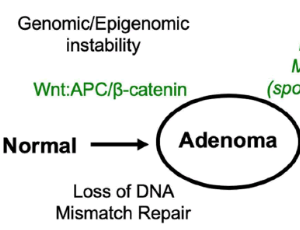
A New Study Uncovering the Cause of Health Deterioration and Mortality in Late-stage Cancer Patients
Lingbing Zhang
Cachexia [Greek origin, Etymology: kakos (bad) and hexes (condition)] is a complex metabolic syndrome associated with underlying illness and characterized by loss of muscle mass with or without loss of body fat. This syndrome can be linked to anorexia, inflammation, insulin resistance, and raised protein turnover. Cachexia is typically found to be associated with severe disorders such as chronic heart/renal failure, cancer, and autoimmune diseases. This condition results in deprived nutrition and decreased skeletal muscle mass.
J Cancer Immunol, 2024, Volume Volume 6, Issue Issue 3, p119-124 | DOI: 10.33696/cancerimmunol.6.092
Blood Clotting Contributes to a Malignant Glioma Phenotype: A Commentary
Lynn M. Knowles, Tamara C. Kiwitt, Jan Pilch
High-grade gliomas are malignant brain tumors that are derived from glial progenitors, oligodendrocytes or astrocytes. The prognosis of malignant glioma is poor with an overall survival of 12-15 months for glioblastoma (GBM) and 2-5 years for anaplastic glioma. A hallmark of glioma is the diffuse infiltration of the neuropil, which regularly prevents complete surgical removal even in premalignant lesions. While gliomas are generally considered to be non-metastatic, they are able to activate transcriptional programs known to promote mesenchymal cell functions that are associated with increased tumor cell invasion, a high rate of proliferation and poor patient survival.
J Cancer Immunol, 2025, Volume Volume 7, Issue Issue 3, p123-127 | DOI: 10.33696/cancerimmunol.7.111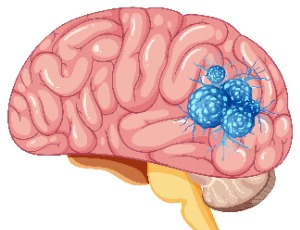
Commentary: On the Emerging Role of Innate Lymphoid Cells in Bladder Cancer
Zaineb Hassouneh, Gang Huang, Nu Zhang, Manjeet Rao, Neelam Mukherjee
In the evolving landscape of bladder cancer (BCa) immunotherapy, this commentary offers a critical and timely reflection on a recent review that we published previously on targeting innate lymphoid cells (ILCs) in BCa. Even though BCa immunotherapy has traditionally focused on enhancing T-cell responses, the review explores the promising but underappreciated role of ILCs in BCa. From natural killer cells to the diverse ILC subtypes, these cells offer a dualistic impact on tumor progression and immune surveillance.
J Cancer Immunol, 2024, Volume Volume 6, Issue Issue 3, p125-134 | DOI: 10.33696/cancerimmunol.6.093
Prevention of Lung Cancer Growth by Water Extract from Euglena gracilis
Susumu Ishiguro, Jeffrey Comer, Masaaki Tamura
As a source of novel drugs and dietary supplements, natural products from plants and animals have been studied for more than decades. Unicellular algae, such as Chlorella, Spirulina and Euglena, are such resources. Euglena gracilis is a unicellular green alga found in fresh water. This organism possesses features characteristic of both animals and plants, having the ability to swim by means of flagella and to photosynthesize.
J Cancer Immunol, 2020, Volume Volume 2, Issue Issue 3, p128-132 | DOI: 10.33696/cancerimmunol.2.025
AminoTricomplex Therapy in Advanced Triple-Negative Breast Cancer: A Translational Study Linking Survivin Downregulation, Cystatin C Upregulation, and MT1 Receptor Re-Expression to Clinical Outcomes
Alexandre Tavartkiladze, Gaiane Simonia, Russel J Reiter, Ruite Lou, Nana Okrostsvaridze, Dinara Kasradze, Pati Revazishvili, Irine Andronikashvili, Pirdara Nozadze, Givi Tavartkiladze, Rusudan Khutsishvili, Tatia Potskhoraia
Breast cancer remains the most frequently diagnosed malignancy in women worldwide. TNBC—defined by the absence of estrogen receptor (ER), progesterone receptor (PR), and human epidermal growth factor receptor 2 (HER2)—comprises ~15–20% of cases and is disproportionately represented among younger women, women of African ancestry, and carriers of germline BRCA1 mutations.
J Cancer Immunol, 2025, Volume Volume 7, Issue Issue 3, p128-143 | DOI: 10.33696/cancerimmunol.7.112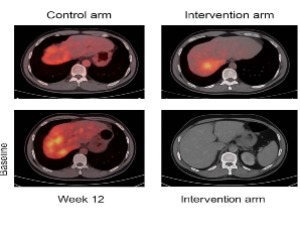
- Abstract |
- Full Text |
- Cite |
- Supplementary File
Hepatocellular Carcinoma: Animal Models Available to Characterize Tumor Immunology and Optimize Treatment Development
Gael S Roth, Zuzana Macek Jilkova, Thomas Decaens
Hepatocellular carcinoma (HCC) is the second cause of cancer-related death worldwide with almost 1 million new cases per year. At the diagnosis, 70% of patients have only access to a palliative treatment with few therapeutic options mostly represented by tyrosine kinase inhibitors such as sorafenib and lenvatinib in first line; regorafenib and cabozantinib in second line.
J Cancer Immunol, 2020, Volume Volume 2, Issue Issue 4, p133-137 | DOI: 10.33696/cancerimmunol.2.026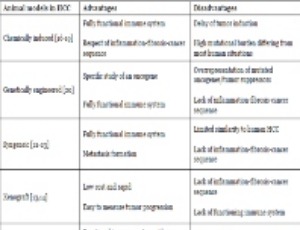
Phosphopeptide Neoantigens as Emerging Targets in Cancer Immunotherapy
Apoorvi Tyagi, Yury Patskovsky, Iryna Voloshyna, Michelle Krogsgaard
Protein post-translational modifications play a vital role in various cellular events essential for maintaining cellular physiology and homeostasis. In cancer cells, aberrant post-translational modifications such as glycosylation, acetylation, and phosphorylation on proteins can result in the generation of antigenic peptide variants presented in complex with MHC molecules. These modified peptides add to the class of tumor-specific antigens and offer promising avenues for targeted anti- cancer therapies. In this review, we focus on the role of phosphorylated peptides (p-peptides) in cancer immunity.
J Cancer Immunol, 2024, Volume Volume 6, Issue Issue 4, p135-147 | DOI: 10.33696/cancerimmunol.6.094
Dose-dependent Effects of Vitamin C on Cancer Regulation: A Review
Faheem Hadi, Tahir Maqbool, Saira Aftab, Muhammad Tahir, Shazia Ramzan, Komal Kiran, Arif Malik, Shabana Akhtar
Vitamin C, also known as ascorbate or ascorbic acid, is an essential water-soluble vitamin required for several physiological mechanisms in plant and animal cells.
J Cancer Immunol, 2021, Volume Volume 3, Issue Issue 2, p137-142 | DOI: 10.33696/cancerimmunol.3.048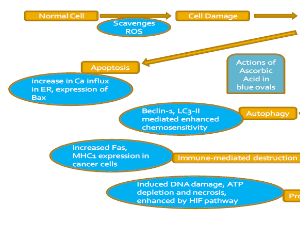
Mitochondria Autoimmunity and MNRR1 in Breast Carcinogenesis: A Review
Félix Fernández Madrid, Lawrence I. Grossman, Siddhesh Aras
We review here the evidence for participation of mitochondrial autoimmunity in BC inception and progression and propose a new paradigm that may challenge the prevailing thinking in oncogenesis by suggesting that mitochondrial autoimmunity is a major contributor to breast carcinogenesis and probably to the inception and progression of other solid tumors. It has been shown that MNRR1 mediated mitochondrial-nuclear function promotes BC cell growth and migration and the development of metastasis and constitutes a proof of concept supporting the participation of mitochondrial autoimmunity in breast carcinogenesis.
J Cancer Immunol, 2020, Volume Volume 2, Issue Issue 4, p138-158 | DOI: 10.33696/cancerimmunol.2.027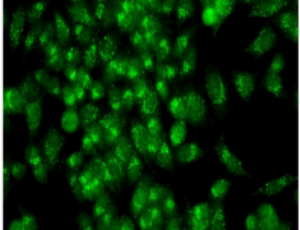
Quantifying Neural Stem Cell-Derived Extracellular Vesicle Uptake Using Imaging Flow Cytometry
Taylor J. Elliso, Brian J. Jurgielewicz, Steven L. Stice, Yao Yao
Nanomedicine, which includes nanoparticles and other nanomaterials for diagnosis and therapeutic delivery to treat numerous diseases, is making advances.
J Cancer Immunol, 2021, Volume Volume 3, Issue Issue 3, p143-146 | DOI: 10.33696/cancerimmunol.3.049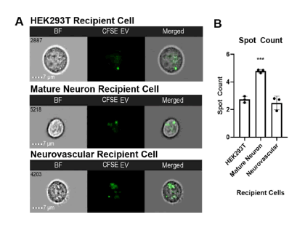
Profiling the Energy Metabolism at the Cell Subpopulation Level
Karim Benihoud, Catherine Brenner
Although being a complex pathology with genetic as well as non-genetic etiologies, cancer is characterized by a limited series of hallmarks including energetic metabolism reprogramming.
J Cancer Immunol, 2021, Volume Volume 3, Issue Issue 3, p147-150 | DOI: 10.33696/cancerimmunol.3.050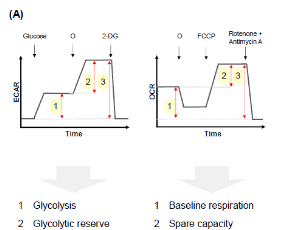
A Blood-based Metabolite Signature for Personalized Risk Assessment of Pancreatic Cancer
Ricardo A León-Letelier, Yihui Chen, Riccardo Ballaro, Ehsan Irajizad, Kim-An Do, Anirban Maitra, Jianjun Zhang, C Max Schmidt, Johannes F. Fahrmann
Pancreatic ductal adenocarcinoma (PDAC) is the third most common cause of cancer-related deaths in the United States. Modeling studies project PDAC to be the second leading cause of cancer-related mortality by 2040. Poor survival rates are attributed to the overwhelming majority (>80%) of patients presenting with locally advanced or metastatic disease, which precludes surgical resection and possibility of a long-term cure.
J Cancer Immunol, 2024, Volume Volume 6, Issue Issue 4, p148-153 | DOI: 10.33696/cancerimmunol.6.095
Anti-PD1 Therapy in Lynch Syndrome-associated Recurrent Glioblastoma
Wendy J Sherman
When a patient is diagnosed with a glioblastoma, they are often blindsided with the diagnosis, experiencing symptoms typically developing over only days to weeks and then often undergoing a craniotomy within days of presentation, only to then be given a terminal diagnosis.
J Cancer Immunol, 2021, Volume Volume 3, Issue Issue 3, p151-153 | DOI: 10.33696/cancerimmunol.3.051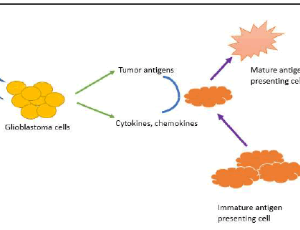
Tolerogenic De-liver-y: Glycopolymer-mediated Approaches to Induce Antigen-specific Tolerance
Ian Christopher McKnight, Stephane Lajoie, David Scott Wilson
Numerous autoimmune diseases, which currently affect a sizable portion of the global population, are driven by aberrant autoantigen-specific T cell responses that result in tissue destruction and loss of function. Current therapeutics for autoimmunity are non-curative and rely on global immunosuppression, leaving patients vulnerable to opportunistic infections and malignancies. An ideal approach would suppress autoantigen-specific T cell responses while leaving the remainder of the immune system intact
J Cancer Immunol, 2024, Volume Volume 6, Issue Issue 4, p154-161 | DOI: 10.33696/cancerimmunol.6.096
Polycyclic Aromatic Hydrocarbons and Mammary Cancer Risk: Does Obesity Matter too?
Lydia Lichtiger, Janelle Rivera, Debashish Sahay, Rachel L. Miller
Breast cancer is the most commonly diagnosed cancer in women in the United States. Breast cancer incidence rates, particularly among younger women, have been increasing since the 1930s, and are only partially explained by changes in parity, age at first birth, and improved screening and detection. Many questions remain unanswered regarding the mechanisms that underlie current risk.
J Cancer Immunol, 2021, Volume Volume 3, Issue Issue 3, p154-162 | DOI: 10.33696/cancerimmunol.3.052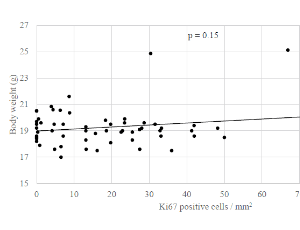
Immunotherapy in Pediatric Acute Lymphoblastic Leukemia
Julie M. Asare, Cara A. Rabik, Stacy Cooper, Patrick A. Brown
Leukemia is the most common childhood malignancy and cause of pediatric cancer death. Significant advances in the cure rates of B-cell acute lymphoblastic leukemia (B-ALL) and T-cell acute lymphoblastic leukemia (T-ALL) have been achieved; however, patients with refractory or relapsed B-ALL or T-ALL continue to have poor outcomes. Immunotherapy is a revolutionary treatment aimed to improve survival and reduce the toxicity of chemotherapy by harnessing the patient’s own immune system to target cancer cells.
J Cancer Immunol, 2020, Volume Volume 2, Issue Issue 4, p159-184 | DOI: 10.33696/cancerimmunol.2.028
Effects of Tumor-derived Small Extracellular Vesicles on T cell Survival in Patients with Cancer; A Commentary
Theresa L. Whiteside
Tumor-induced immune suppression has been recognized as one of the major barriers for cancer immune therapies, including checkpoint inhibitors. Immunosuppressive mechanisms that tumors utilize to silence anti-tumor immune cells are numerous and differ between tumor types.
J Cancer Immunol, 2024, Volume Volume 6, Issue Issue 4, p162-168 | DOI: 10.33696/cancerimmunol.6.097
High Expression of TIM 3 and Galectin 9 on Immunohistochemistry Staining of Tumor Specimen at Diagnosis in Pediatric Patients with Ewing Sarcoma
Stephanie J. Si, Gerald B. Wertheim, David M. Barrett
The concept of immunotherapy has been traced as far back to third century BC Qin dynasty in China through the purposeful inoculation of Variola minor to prevent smallpox.
J Cancer Immunol, 2021, Volume Volume 3, Issue Issue 3, p163-176 | DOI: 10.33696/cancerimmunol.3.053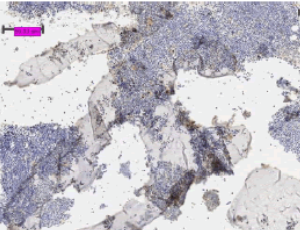
Beyond the Mutation: A Closer Look at Birt-Hogg-Dubé Syndrome
Alamin Alkundi, Basma Bakhiet
This commentary aims to delve into the diagnostic challenges associated with Birt-Hogg-Dubé (BHD) syndrome, as outlined in the BMJ case report titled “A Case of Phaeochromocytoma in a Female Patient with Phenotypical Expressions for the Rare Birt-Hogg-Dubé (BHD) Syndrome” (doi:10.1136/bcr-2022- 252362). BHD syndrome is a rare genetic disorder that is inherited in an autosomal dominant manner and is caused by mutations in the FLCN gene on chromosome.
J Cancer Immunol, 2024, Volume Volume 6, Issue Issue 4, p169-171 | DOI: 10.33696/cancerimmunol.6.098
Therapeutic Monoclonal Antibodies: Future Prospectives
Lobna Abdel Aziz Kilany, Mohammad Mabrouk Aboulwafa, Hamdallah Hafez Zedan
Therapeutic monoclonal antibodies (mAb) have the potential to treat a wide range of various diseases and disorders including cancer, chronic autoimmune and inflammatory diseases, allergies, infections, transplantations, and cardiovascular diseases.
J Cancer Immunol, 2021, Volume Volume 3, Issue Issue 4, p177-182 | DOI: 10.33696/cancerimmunol.3.054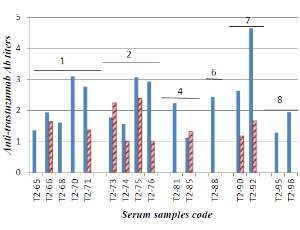
Humanized Chimeric Antigen Receptor (CAR) T cells
Pouya Safarzadeh Kozani, Pooria Safarzadeh Kozani, Roddy S. O’Connor
In 1989, researchers proposed an intricate strategy in the field of adoptive cell therapy (ACT). Using the T-cell receptor (TCR) as a template, they replaced the coding sequence for the Vα and Vβ chains with the antigen- recognition domains from an antibody (VH and VL chains).
J Cancer Immunol, 2021, Volume Volume 3, Issue Issue 4, p183-187 | DOI: 10.33696/cancerimmunol.3.055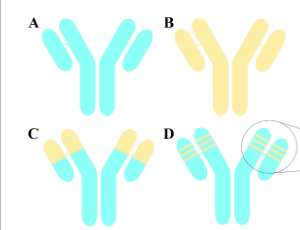
Ovarian Function Suppression Plus Aromatase Inhibitors or Tamoxifen in Premenopausal HR-positive Breast Cancer
Xueqing Xie, Yiqun Yao, Dianlong Zhang
Breast cancer is the most common type of malignant tumor in women, accounting for 30% of women’s cancer, while the mortality rate ranks second among women’s cancer. Twenty-five percent of all breast cancer patients are premenopausal patients, and 7% of patients are younger than 40 years old.
J Cancer Immunol, 2020, Volume Volume 2, Issue Issue 4, p185-193 | DOI: 10.33696/cancerimmunol.2.029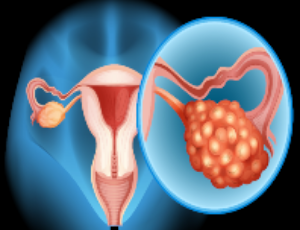
Biomarkers of Pembrolizumab Efficacy in First-Line Advanced PD-L1 ≥ 50% Non-Small Cell Lung Cancer Treatment
Luis Cabezón-Gutiérrez, Sara Custodio-Cabello, Magda Palka-Kotlowska, Silvia María Sanchez-Luis, Parham Khosravi-Shahi
Lung cancer is the leading cause of cancer death worldwide. In 2020, a total of 19 million cancer patients were diagnosed, of which 11.4% were lung cancer, causing 18% of all cancer deaths. In 2020 in Spain, 29,638 cases were estimated.
J Cancer Immunol, 2021, Volume Volume 3, Issue Issue 4, p188-195 | DOI: 10.33696/cancerimmunol.3.056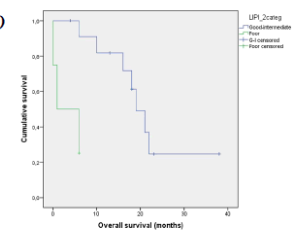
Management of Appendiceal Neuroendocrine Tumors: Beyond Tumor Size
Jace P. Landry, Yvette B. Mattison, Robert A. Ramirez, J. Philip Boudreaux, Eugene A. Woltering, Mary A. Maluccio, Ramcharan Thiagarajan
Appendiceal neuroendocrine tumors (ANETs) less than 2 cm were thought to have no metastatic potential; however, recent evidence including our previous report shows increasing occurrences of regional and metastatic disease in smaller ANETs. We provided an update of patients with ANETs at our institution. A retrospective review was performed in a follow-up series of patients with ANET who presented to our tertiary referral center from 2019-2020. Demographics, tumor characteristics, treatment, and clinical outcomes were evaluated.
J Cancer Immunol, 2020, Volume Volume 2, Issue Issue 4, p194-198 | DOI: 10.33696/cancerimmunol.2.030
Immunophenotypic Characterization by Flow Cytometry of Chronic Lymphoid Leukemia
Yenisey Triana Marrero, Vianed Marsán Suárez, Yaneisy Duarte Pérez, Gabriela Díaz Domínguez, Imilla Casado Hernández, Elizabeth Hernández Ramos, Rosa María Lam Díaz, Consuelo Milagros Macías Abraham
Chronic lymphoid leukemia (CLL) is a malignant hematological disease characterized by the accumulation of mature lymphocytes with a defect in the induction of apoptosis that massively accumulate in peripheral blood (PB), bone marrow (BM) and lymphoid tissues.
J Cancer Immunol, 2021, Volume Volume 3, Issue Issue 4, p196-205 | DOI: 10.33696/cancerimmunol.3.057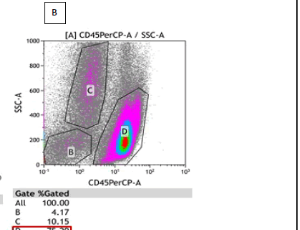
Emerging Strategies to Attack Polyploid Cancer Cells
Jing Zhang, Shenqiu Zhang, Qiong Shi, Dun Yang, Thaddeus D. Allen
Polyploid cancer cells can arise de novo in tumors or they can be induced by therapeutics that inadvertently increase the rate of cytokinetic failure. These cells portend a poor outcome in many cancers because polyploid cancer cells can undergo error prone reductive cell divisions to yield aneuploid progeny. The immune system has evolved mechanisms by which it can specifically recognize and remove polyploid cancer cells, but these appear to be tampered with malignancy so that polyploid cells can persist and fuel the development of cancer cell clones that are resistant to therapeutics and have metastatic potential.
J Cancer Immunol, 2020, Volume Volume 2, Issue Issue 4, p199-206 | DOI: 10.33696/cancerimmunol.2.031
High Lymph Node Positive to Sampled Ratio as a Potential Indication for Postoperative Radiation Therapy in Patients with pN2 Non-small-cell Lung Cancer
Nikhil P. Mankuzhy, Muayad F. Almahariq, Craig W. Stevens, Thomas J. Quinn
The role for postoperative radiation therapy (PORT) for patients with non–small-cell lung cancer (NSCLC) with mediastinal lymph node (LN) involvement (pN2 disease) is controversial. We performed a SEER analysis comparing surgery alone with PORT among patients with pN2 NSCLC. As we await the final results of the LUNG ART trial, a subset of patients with a high LN positive to sampled (LPR) ratio may benefit from PORT.
J Cancer Immunol, 2020, Volume Volume 2, Issue Issue 4, p207-210 | DOI: 10.33696/cancerimmunol.2.032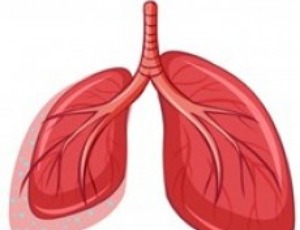
Susceptibility of Malignant Brain Tumors to 5-aminolaevulinic Acid Mediated Photodynamic Therapy: Direct Phototoxicity and Immunological Effects
Angeliki Datsi, Rüdiger V. Sorg
Recently we published the article ‘Accumulation of protoporphyrin IX in medulloblastoma cell lines and sensitivity to subsequent photodynamic treatment’. In this commentary, we review protoporphyrin IX accumulation after application of 5-aminolaevulinic acid and the resulting sensitivity of medulloblastoma cells to photodynamic therapy. We compare the results to glioblastoma cells, including glioblastoma stem-like cells, and address the contribution of the transporter adenosine triphosphate binding cassette subfamily G member 2 (ABCG2) as well as the enzyme ferrochelatase to the process.
J Cancer Immunol, 2020, Volume Volume 2, Issue Issue 4, p211-215 | DOI: 10.33696/cancerimmunol.2.033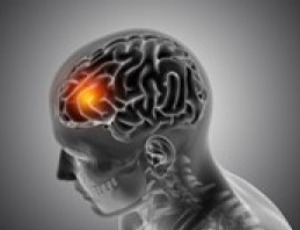
SPANX Regulation of LAMIN A/C Network: Perspectives in Cancer and Laminopathies
Ikrame Lazar, Bertrand Fabre
Cancer/testis antigens (CTA) are tumor antigens whose expression is normally restricted to the testis. More than half of CTA genes are located on the X chromosome and form a branch called X-CTA [1]. Unlike the remaining CTA genes located throughout the genome, multigene X-CTA families are present as clusters on the X chromosome. Among them, the Sperm Protein Associated with the
Nucleus on the X chromosome (SPANX) family is composed by five members [SPANX-A1, -A2 (-A1 and -A2 being two copies of the same gene), -B1, -C and -D]. As SPANX proteins are highly homologous and cannot be distinguished by antibody-based techniques, unless stated otherwise, hereafter we will use the term “SPANX” to refer to these five proteins.

About Scientific Archives
Scientific Archives is a global publisher initiated with the mission of ensuring equal opportunity for accessing science to research community all over the world. Spreading research findings with great relevance to all channels without any barrier is our goal. We want to overcome the challenges of Open Access with ensured quality and transparency.

